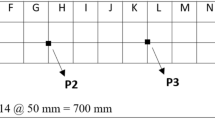Abstract
The method of compliance calibration for estimating crack growth in notched beams of metallic materials and nonmetallic materials such as rock has been used extensively with success. This method has also been used with concrete, but recently its suitability for this material has been questioned. The validity of this method has been evaluated using concrete beams in three-point bending in which the crack surface is revealed by a dye-penetrant technique.
The results of this study, which utilized twelve specimens precracked to varying depths and thirteen companion specimens using 0.076-mm thick Teflon notches of various depths, are presented. It was found that the compliance estimates of crack length agreed exactly with the actual length for the beams with Teflon notches. For the precracked beams the compliance estimates for crack length were in good agreement with the actual length observed at the beam surface (thus confirming previously reported results) but were greater than the average crack length revealed by dye.
Similar content being viewed by others
Abbreviations
- a :
-
crack length
- CMOD:
-
crack-mouth-opening displacement
- K 1 :
-
opening-mode stress-intensity factor
- P :
-
load on beam
- P′:
-
load on inverted beam used to open the crack for dye insertion
- W :
-
depth of beam
References
Experimental Techniques in Fracture Mechanics, ed. A.K. Kobayashi, SESA, Monograph No. 1 (1973).
Schmidt, R.A., “Fracture Toughness Testing of Limestone,”Experimental Mechanics,16 (5), (May 1976).
Swartz, S.E., Hu, K.-K. and Jones, G.L., “Compliance Monitoring of Crack Growth in Plain Concrete,” J. Struct. Div., ASCE,104 (EM4), (Aug. 1978).
Swartz, S.E., Hu, K.K. and Jones, G.L., “Techniques to Monitor Crack Growth in Plain Concrete Beam,” Experimental Techniques,6 (6), (Dec. 1982).
Swartz, S.E., Hu, K.K., Fartash, M. and Huang, C.-M.J., “Stress-intensity Facotr for Plain Concrete in Bending—Prenotched Versus Precracked Specimens,” Experimental Mechanics,22 (11), (Nov. 1982).
Velazco, G., Visalvanich, K. and Shah, S.P., “Fracture Behavior and Analysis of Fiber Reinforced Concrete Beams,” Cement and Concrete Res.,10 (Jan. 1980).
Wecharatana, M. andShah, S.P., “Experimental Methods to Determine Fracture Parameters for Concrete,”presented at Seminaire Mechanique de la Rupture, College International des Sciences de la Construction, Saint-Remy-les Chevreuse, France, (Technological Institute, Northwestern Univ., Evanston, IL), (June1982).
Wecharatana, M. and Shah, S.P., “Slow Crack Growth in Cement Composite,” J. Struct. Div., ASCE,108 (ST6), (June 1982).
Carpinteri, A., “Application of Fracture Mechanics to Concrete Structures,” J. Struct. Div., ASCE,108 (ST4), (April 1982).
Go, C.G. and Swartz, S.E., “Fracture Toughness Techniques to Predict Crack Growth and Tensile Failure in Concrete,” Kansas State Univ. Bull., Engrg. Experiment Station, Rep. No. 154 (July 1983).
Author information
Authors and Affiliations
Rights and permissions
About this article
Cite this article
Swartz, S.E., Go, C.G. Validity of compliance calibration to cracked concrete beams in bending. Experimental Mechanics 24, 129–134 (1984). https://doi.org/10.1007/BF02324995
Received:
Revised:
Issue Date:
DOI: https://doi.org/10.1007/BF02324995




